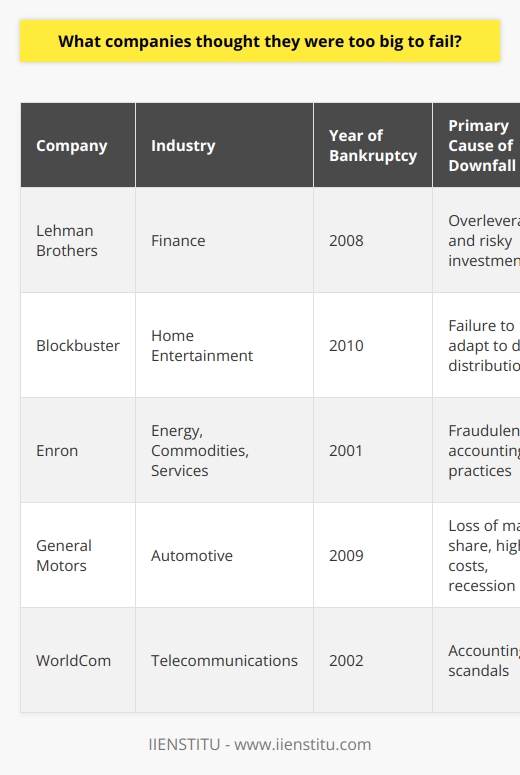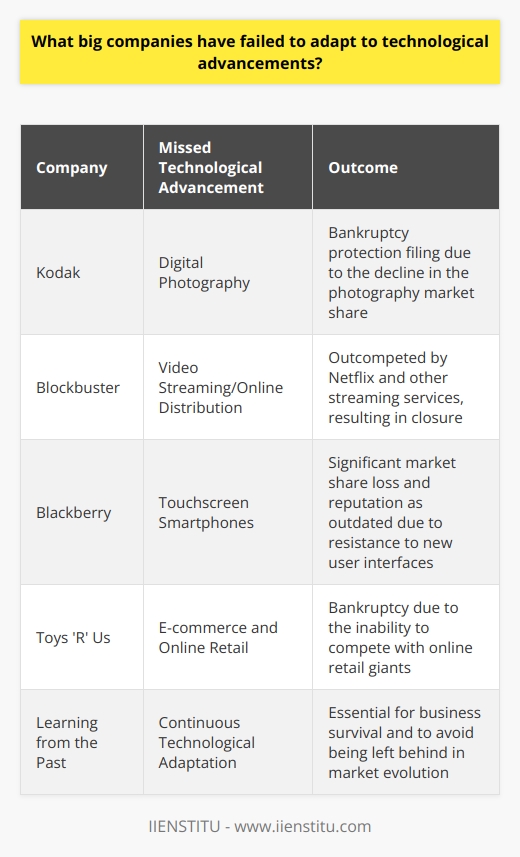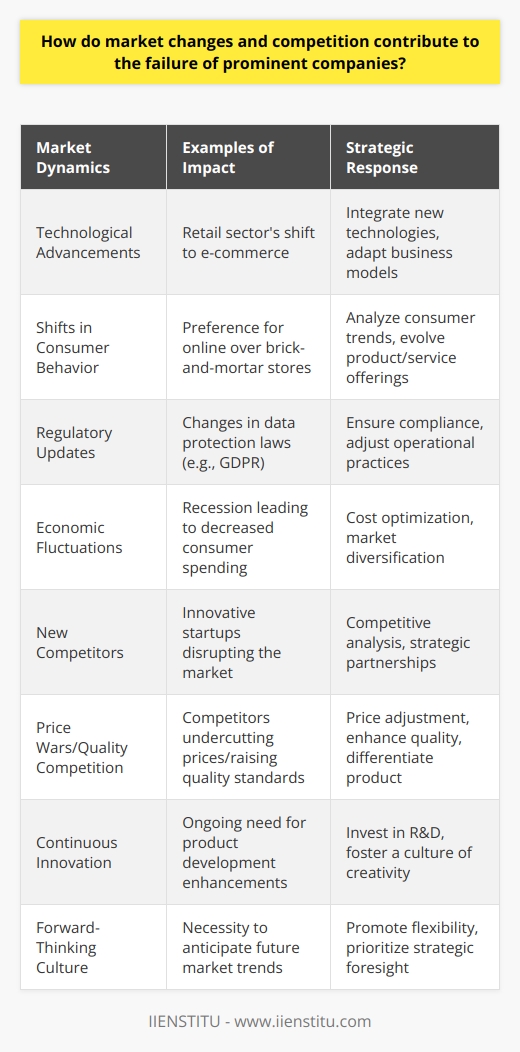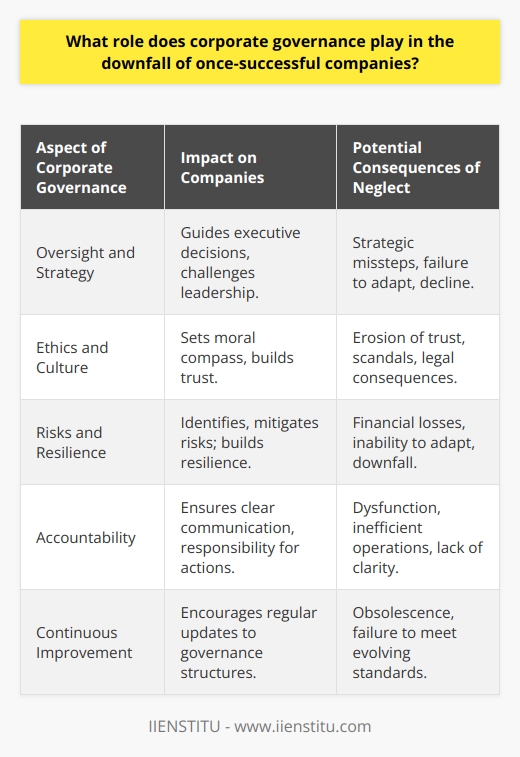
For every successful business, there are plenty of failed ones. Statistics show that the majority of companies fail within the first five years. So, what goes wrong? Why do some businesses make it while others don't?
Businesses fail for many reasons, but some common factors include poor management, inadequate funding, unrealistic goals, and a lack of customer demand. Let's take a closer look at each of these factors.
But first, let's see what Steve Jobs says.
Steve Jobs explains why companies fail.
"I'm saddened to report that I've failed a lot in the past 33 years. I've failed repeatedly in my life," says Steve Jobs, the man behind Apple's success. "And that is why I've been able to succeed."
Jobs is not alone in his failures. Many of the most successful people have failed time and time again before they finally found success. The difference between them and those who don't make it is that they learn from their mistakes.
So, what can we learn from the failures of others? Here are four common reasons why businesses fail:
Startups are complex organisms that require a delicate balance of many different factors in order to thrive. Unfortunately, even the best-laid plans can sometimes come undone, and startups often fail for a variety of reasons. According to recent studies, the most common cause of startup failure is running out of cash or failing to raise new capital.
This is closely followed by situations where there is simply no market need for the product or service being offered. In other cases, startups may be outcompeted by larger, more established companies, or they may be hamstrung by flawed business models.
Regulatory or legal challenges can also be difficult to overcome, and pricing or cost issues are often cited as well. Finally, it's worth noting that startups are often reliant on the skill and expertise of their team members.
If the wrong people are in place, it can spell disaster for the company.
Poor management
One of the most common reasons for business failure is poor management. This can manifest itself in several ways, such as a lack of clear goals, a lack of delegation, and micromanagement. These issues ultimately stem from failing to understand and utilize available resources appropriately.
When faced with limited resources, it is essential to set clear goals and delegate tasks efficiently to make the most of what is available. Without these critical components of good management, it is tough for a business to succeed. As a result, failed companies often have one thing in common: poor management.
While there are many successful businesses, there are also plenty of examples of poor management. Sometimes, this can lead to a downward spiral from which the company never recovers. Let's take a look at a few case studies of businesses that have been poorly managed.
One example is Enron, which was once one of the largest energy companies in the world. However, due to widespread fraud and mismanagement, it collapsed spectacularly in 2001. This led to hundreds of millions of dollars in losses for investors and left thousands of employees without jobs.
Another example is Lehman Brothers, an investment bank that went bankrupt in 2008 due to irresponsible lending and Risky financial practices. This caused massive economic disruption and led to the loss of billions of dollars in value.
These are just two examples of businesses brought down by bad management. In both cases, investors and employees were left with significant losses. It's essential to learn from these examples and ensure that proper safeguards are in place to prevent similar disasters from happening in the future.
Inadequate funding
Inadequate funding is one of the most common reasons businesses fail. While a number of factors can contribute to this, it often boils down to one thing: not having enough money. This can be due to overspending, not securing enough investment, or simply not having enough cash reserves.
Whatever the cause, inadequate funding can quickly lead a business to failure. This is why it is crucial for companies to carefully track their spending and ensure they have enough money available to meet their needs. By doing so, they can avoid the pitfalls of inadequate funding and give themselves the best chance for success.
Every year, startups across the country compete for a limited pool of venture capital. While some companies can secure the funding to grow and scale, others are forced to close their doors due to a lack of financial support. Inadequate funding is often cited as one of the leading causes of failed businesses.
One notable example is the online retailer Zappos, founded in 1999. The company struggled to secure funding in its early years and was close to bankruptcy several times. However, Zappos eventually secured $1 million in venture capital and became one of the most successful online retailers in history.
Another example is Vine's social media platform, launched in 2013. Vine quickly gained popularity among users but could not generate enough revenue to sustain itself. As a result, Vine was shut down in 2016 after just three years of operation.
While many factors can contribute to a business failure, inadequate funding is often cited as one of the leading causes. These examples illustrate the importance of securing sufficient funding for a startup business.
Unrealistic goals
Unrealistic goals are one of the main reasons businesses fail. This can be due to several factors, such as setting unrealistic sales targets, expanding too quickly, or trying to do too much at once. When business owners set unattainable goals, it sets them up for disappointment and can lead to disillusionment with the entire enterprise.
Additionally, employees may become demotivated if they constantly fall short of expectations. Therefore, it is essential for business owners to set realistic goals that take into account all of the factors involved in running a successful operation. Only then can they hope to achieve lasting success.
There are many examples of companies that have failed because they set unrealistic goals. For instance, smartphone maker Blackberry tried to compete with Apple and Samsung by releasing a series of high-end devices. However, the company failed to gain traction with consumers and eventually had to abandon its hardware business altogether.
Similarly, online retailer Amazon was initially unsuccessful in its attempts to enter the streaming video market. The company poured billions of dollars into developing original content, but it ultimately had to admit defeat and write off billions in losses. These examples show that even well-established companies can fail if they pursue goals beyond their reach.
Lack of customer demand
Businesses require customers to generate revenue and ultimately be successful. However, there are many reasons why a company may struggle to find customers, or customer demand might diminish. If businesses cannot identify these reasons, they may soon work to stay afloat.
One reason businesses may fail to attract customers is if there has been a shift in the market. For example, if a new technology emerges, that makes the business's product or service obsolete, this can result in a dramatic drop in demand. Other times, changing consumer preferences can lead to companies failing to meet customer needs. For example, if healthy eating becomes popular, a restaurant specializing in unhealthy fast food will likely decrease customers.
Another reason businesses may fail to generate customer demand is if they do not have a unique selling proposition. For businesses to succeed, they need to offer something that sets them apart from their competitors. If all companies in an industry are offering the same thing, it can be difficult for consumers to decide which one to choose. As such, businesses need to ensure that they offer something unique that will make consumers want to purchase from them over other options.
Finally, another reason businesses fail is due to poor marketing. Marketing is essential for companies to reach their target consumers and generate demand. However, if businesses do not have an effective marketing strategy, they will likely struggle to develop the necessary customer interest.
Additionally, even if a business has a great product or service, it will fail if no one knows about it. This is why companies need to ensure they are investing in effective marketing campaigns to reach their target consumers and create demand for their products or services.
So, there you have it. These are four common reasons why businesses fail. If you want your business to succeed, avoid these pitfalls. And if you do make a mistake, learn from it and move on.
After all, even the most successful people have failed before finding success.
Famous failed companies
1. Blockbuster
2. Borders
3. Sears
4. Toys "R" Us
5. GoPro
6. JCPenney
7. Pier 1 Imports
8. Forever 21
9. Barneys New York
10. Juul Labs

Frequently Asked Questions
What do you think is the biggest reason for a company's failure?
There are many factors that can contribute to a company's failure, but I believe the most important one is poor strategic planning. A company's strategy is its blueprint for success, and if that blueprint is flawed, the entire enterprise is likely to crumble.
Many companies fail to adequately assess their strengths and weaknesses, set realistic goals, or identify threats and opportunities in their industry. As a result, they make bad decisions that put them at a disadvantage relative to their competitors.
In today's hyper-competitive business environment, even a small mistake can be costly, and companies that don't plan carefully are unlikely to survive.
Do you think it's possible to learn from other companies failures?
Every company experiences challenges and setbacks, and it is often possible to learn from the failures of others. By studying the mistakes of other businesses, it is possible to gain a better understanding of what NOT to do in order to avoid similar challenges.
For example, if a company has struggled with poor customer service, it may be helpful to examine their policies and procedures to see where they went wrong. In addition, by speaking with employees or customers of the failing company, it may be possible to get first-hand insights into what went wrong.
Learning from the failures of others can help to prevent similar problems from occurring in your own business.
Why do you think some companies are able to recover after a failure while others aren't?
There can be many reasons why some companies are able to recover after a failure while others aren't. One key reason may be the company's financial resources. Companies with deep pockets may be able to weather a failure and rebound quickly, while those without the same financial cushion may struggle to recover.
Another important factor is the company's reputation. A company with a strong reputation may be able to weather a setback and retain customer confidence, while a company with a weaker reputation may find it harder to win back customers after a failure. Finally, the company's management team also plays a critical role in recovery.
A team that is able to learn from mistakes and make necessary changes is more likely to lead the company to success than a team that is unable or unwilling to change.
In short, there are many factors that can contribute to a company's ability to recover from failure, but financial resources, reputation, and management are three of the most important.

What are the 4 main reasons why companies fail?
Reason 1: Inadequate Business Planning
A primary factor attributing to company failure is the absence of a comprehensive business plan. Without laying a solid groundwork, entrepreneurs cannot anticipate potential challenges or design appropriate contingency measures for various scenarios, thus struggling to steer their organization on a sustainable growth trajectory.
Reason 2: Poor Financial Management
Another critical reason for company failure is poor financial management. Inability to maintain a healthy cash flow, monitor profit margins, and control expenses can lead to a financial crisis within the organization. A strong financial management system enables companies to hone their decision-making process and remain solvent in difficult times.
Reason 3: Ineffective Leadership
Ineffective leadership has a direct correlation with company failure. Leaders who lack vision, management skills, or the ability to foster a strong company culture can drive the organization towards bankruptcy. On the other hand, capable leaders can propel a company to success by motivating employees, setting achievable goals, and implementing strategic changes to overcome challenges.
Reason 4: Ignoring Market Dynamics
Lastly, disregarding market dynamics contributes to the downfall of many companies. Organizations must be agile and demonstrate adaptability in the face of shifting consumer preferences, new competitors, and emerging technologies. Failure to respond to market changes in a timely manner can leave organizations lagging behind their rivals, ultimately leading to failure.

What is an example of a company that has failed to change?
Failure to Adapt: The Kodak Story
History of Kodak
An iconic example of a company failing to change and adapt to new technologies is the once-dominant photography giant, Eastman Kodak. Founded in 1888, Kodak became synonymous with capturing memories through easy-to-use cameras and film. However, with the advent of digital photography, Kodak's inability to truly embrace digital innovation led to its downfall.
Ignoring Digital Trends
Interestingly, it was a Kodak engineer who invented the first digital camera in 1975; however, Kodak's leadership feared that embracing digital technology too early would cannibalize their film business. As a result, they missed the opportunity to be a market leader in digital photography, allowing competitors like Sony and Nikon to pave the way.
Market Decline
Kodak experienced a slow decline for decades, ultimately losing a significant portion of its market share. The rise of smartphones with built-in cameras accelerated the decline, as consumers opted for the convenience and immediacy offered by smartphones over traditional film cameras. In January 2012, Kodak filed for bankruptcy protection, symbolizing the end of an era for the once-dominant photography company.
Innovation Missteps
Kodak did attempt to enter the digital market, but its efforts were overshadowed by competitors who fully embraced the digital revolution. The company launched its own online photo-sharing website, the Kodak Gallery, and produced digital cameras and photo printers. However, their products were often seen as inferior and outdated compared to rival offerings.
Lessons to Learn
The failure of Kodak serves as a cautionary tale for companies, emphasizing the importance of embracing disruptive technologies and adapting to changing market conditions. Today's businesses must be agile, innovative, and responsive to consumers' demands in order to thrive in the rapidly evolving global market. By doing so, they can avoid the fate that befell Kodak and ensure long-term success.

What companies thought they were too big to fail?
Companies' Assumption of Invincibility
A few companies believed they were too big to fail, which ultimately proved to be a costly presumption. Specifically, Lehman Brothers and Blockbuster serve as prime examples of this erroneous mindset.
Lehman Brothers: A Case of Overconfidence
Once a leading global financial services firm, Lehman Brothers assumed that its size and influence would protect it from collapse. However, the 2008 financial crisis exposed the company's high-risk investments and significant leverage, leading to its bankruptcy. As a result, Lehman Brothers triggered a global financial meltdown and challenged the perception that size guaranteed stability.
Blockbuster: Complacency in the Face of Change
Similarly, Blockbuster, a former video rental giant, believed it was safe from the threat of new competitors and emerging technologies. Ignoring the burgeoning digital video market and the rise of streaming services (e.g., Netflix), Blockbuster failed to innovate and adapt. Consequently, the once-dominant player declared bankruptcy in 2010, unable to compete with more agile and technologically-adept rivals.
Hubris as a Precipitating Factor
Both Lehman Brothers and Blockbuster's downfalls exemplify the danger of considering oneself impervious to failure. Their size and market dominance bred a sense of complacency, ultimately contributing to their ruin. These cases provide valuable lessons to companies: remaining vigilant and adaptive to a rapidly changing marketplace is paramount for sustainability and success.
Changing the Mindset for Future Success
To avoid the mistakes made by these fallen giants, companies must recognize that no business is immune to failure, regardless of its size. Embracing a culture of continuous improvement, proactively addressing potential threats, and prioritizing innovation will help ensure long-term survival in an ever-evolving global economy.

What big companies have failed to adapt to technological advancements?
Big Companies and Technological Adaptation Failures
Kodak's Decline
One prominent example of a big company failing to adapt to technological advancements is Kodak. As a leading photography and film company for over a century, it neglected to fully embrace digital technology, leading to its eventual bankruptcy in 2012. Kodak's inability to capitalize on its early innovations in digital photography contributed to its decline in the era of smartphones and digital cameras.
Blockbuster's Missteps
Blockbuster, the once-dominant movie rental company, also failed to recognize the potential that rapidly evolving technologies had for its industry. Although it had the opportunity to acquire the fledgling Netflix, Blockbuster failed to see the future of streaming services and the decline of the video rental market, resulting in its demise in 2013. The company's resistance to transition to the digital market ultimately led to its downfall.
Blackberry's Smartphone Struggles
Blackberry, once the premier provider of mobile devices, did not adequately adapt to the emergence of smartphones with touchscreens, falling behind competitors such as Apple and Samsung. Despite early successes with their mobile email devices, Blackberry failed to innovate and keep up with consumer demands, causing its market share to plummet significantly. The company's reluctance to fully embrace touchscreen technology and app ecosystems contributed to its decline.
Toys 'R' Us and E-commerce
The iconic toy retailer Toys 'R' Us failed to adapt to the growing prevalence of e-commerce, and ultimately filed for bankruptcy in 2017. As competitors such as Amazon and Walmart aggressively pursued online sales, Toys 'R' Us lagged behind, having signed a long-term deal with Amazon in 2000 that restricted its own online capabilities. The company's inability to adapt and compete in the online retail space led to its downfall.
Conclusion
In conclusion, big companies such as Kodak, Blockbuster, Blackberry, and Toys 'R' Us have failed to adapt to technological advancements, resulting in significant losses in market share and in some cases, bankruptcy. To remain competitive, companies must not only embrace emerging technologies but also continually innovate to stay relevant in the ever-changing landscape of their respective industries.

How do market changes and competition contribute to the failure of prominent companies?
Effects of Market Changes
Market changes play a crucial role in determining the success or failure of a company. Rapid changes in technology, economic conditions, or consumer preferences are some factors that can negatively impact a company's performance. When an organization fails to adjust or adapt to these transformations, it becomes vulnerable to various challenges, such as reduced market share, profitability declines, and eventually, failure.
Competitive Pressures
Fierce competition can also contribute to the failure of prominent companies, as they face the constant threat of new entrants, product differentiation, or cost leadership by rivals. To sustain their success, companies must continually innovate, develop superior products, and maintain cost competitiveness, as failure to do so can result in losing their market position, customer loyalty, and ultimately, failure.
Adaptability and Innovation
Successful companies are those that can effectively adapt to market changes and competition by implementing innovative strategies, product offerings, and business practices. They consistently engage in market research, seek customer feedback, and follow industry trends to identify potential threats and opportunities. Focusing on creating a unique selling proposition, optimizing operational efficiencies, and strategically investing in marketing and research and development (R&D) is essential for staying ahead of competitors and maintaining market leadership.
In summary, market changes and competition can significantly contribute to the failure of prominent companies if they do not effectively adapt and innovate. Staying ahead of the curve requires vigilance, continuous improvement, and a flexible approach that allows an organization to navigate market fluctuations and successfully outperform competitors.

What role does corporate governance play in the downfall of once-successful companies?
Role of Corporate Governance in Downfalls
Corporate governance significantly influences the trajectory of a company, as it serves as the foundation for decision-making and oversight. A downfall of a once-successful company can be attributed to substandard corporate governance practices, which may manifest in various ways.
Board of Directors' Inefficiency
One crucial element of corporate governance is the board of directors, responsible for steering the organization towards achieving its strategic objectives. A weak or inexperienced board can lead to flawed strategic planning and implementation, resulting in declining performance and ultimately, the downfall of the company. Enhanced monitoring practices and selecting directors with relevant expertise can help avoid this pitfall.
Lack of Ethical Behaviour
The erosion of trust and credibility due to unethical behavior can contribute significantly to a company's demise. A robust corporate governance system ensures adherence to ethical standards and fosters an environment that upholds integrity and transparency. Without these elements, companies may face scandals, legal issues, and damaged reputations, adversely affecting their long-term survival.
Ineffective Risk Management
Adequate corporate governance practices involve timely risk identification and management to ensure the company's continued growth and stability. Inadequate risk assessment and mitigation measures can expose the company to significant financial, operational, or reputational damage. As a result, the company's resilience against market fluctuations and industry challenges will be weakened, potentially leading to its downfall.
Lack of Accountability
Accountability is a cornerstone of effective corporate governance. Failure to establish clear lines of responsibility may result in mismanagement, confusion, and ultimately, damage to the company's performance. To avoid such negative consequences, companies should foster a culture of accountability and transparency, ensuring clear communication, and effective decision-making processes.
In conclusion, corporate governance plays a pivotal role in determining the success or failure of a company. Ensuring sound corporate governance practices, such as maintaining a skilled and diverse board, upholding ethical standards, implementing robust risk management, and fostering accountability, can help organizations avoid pitfalls and thrive in the long run.

What are the top 10 reasons businesses fail?
Lack of Market Research
One of the top reasons businesses fail is inadequate market research. Enterprises may not fully understand the needs and wants of their target audience or may operate in a saturated market.
Inadequate Business Planning
Poor business planning can result in failure for many organizations. A lack of proper financial projections or a weak assessment of the competitive landscape, can cause fiscal instability and inability to adapt to market changes.
Insufficient Capital
Another crucial determinant of business failure is insufficient capital. Entrepreneurs often underestimate the costs of starting up and sustaining the business without realizing the significant expenses and financial commitment required.
Poor Management Skills
Entrepreneurs may have great ideas, but lack the management skills necessary to effectively lead their business. Poor management can lead to issues with employee morale, cost control, and strategic planning.
Lack of Differentiation
Failing to stand out from competitors is a top reason for business failure. If businesses cannot differentiate themselves from other market players, they will find it difficult to attract customers.
Location
A poor business location can severely hurt a company's chances for success. An inadequate site can create difficulties in attracting clientele, can be inconvenient for customers, and may not provide the desired visibility needed for success.
Ineffective Marketing
Many businesses fail due to weak marketing strategies, which can result in a lack of brand recognition and visibility among potential customers. Marketing is vital for businesses to generate leads and establish a brand identity.
Rapid Expansion
Attempting to scale a business too quickly can lead to numerous problems. Expanding too fast might result in increased expenses, logistical challenges, and difficulty maintaining the quality of products or services.
Overextended Financial Resources
Oftentimes, businesses fail because they overextend their financial resources. Failure to keep expenses under control, late payments from clients, or misplaced investment can increase the risk of financial failure.
Ignoring Customer Feedback
Lastly, neglecting customer feedback can lead to business failure. Businesses that do not listen to their customers' opinions and preferences risk losing them to competitors who are more responsive.
In conclusion, businesses must address various factors to ensure success and minimize the risk of failure. Proper research, planning, capital, and management skills are essential, along with paying attention to location, marketing strategies, differentiation, and customer feedback.

How do internal factors such as organizational structure and decision-making processes contribute to company failures?
Organizational Structure
One critical internal factor that contributes to company failures is organizational structure. A poorly designed structure can lead to communication breakdowns, inefficiencies, and power struggles within a company. Businesses with rigid hierarchy can impede flexibility and adaptability, slowing down decision-making and stifling innovation.
Silos and Internal Conflict
Functional silos within a company can result in a lack of collaboration and cooperation among different departments. These divisions often lead to conflicts and competition that hinder overall progress. The resulting turf wars can prevent sharing of crucial information and resources, ultimately affecting the company's bottom line.
Decision-Making Processes
Another significant internal factor that can lead to company failures is the decision-making process. Centralized and top-heavy decision-making can exclude valuable input from employees at all levels. Excluding diverse opinions and expertise can lead to poor decision-making and stifle creativity and innovation.
Lack of Accountability
Ineffective decision-making processes often result in a lack of accountability among employees. When the responsibility is unclear or not appropriately managed, it becomes challenging to identify and address underperformance or wrongdoing. Consequently, issues can escalate and contribute to the company's failure.
Resistance to Change
Organizational culture plays a significant role in the success or failure of a company. Companies that struggle to embrace change may be resistant to new ideas and improvements, inadvertently stifling their own growth. This resistance can hamper decision-making processes and result in the inability to adapt to market changes, ultimately leading to failure.
Inadequate Risk Management
Companies can also fail due to inadequate risk management practices. Poorly assessed risks can lead to hasty decision-making and subsequent negative consequences. Failure to identify and mitigate potential hazards can result in significant financial losses, reputational damage, and ultimately, company failure.
In conclusion, internal factors such as organizational structure and decision-making processes have a significant impact on a company's success or failure. Establishing effective communication, promoting collaboration, and fostering a culture of accountability can help businesses avoid common pitfalls and better position themselves for future growth and success.

Can you provide examples of large corporations that failed due to inadequate risk management practices?
Examples of Corporate Failures
Several large corporations have failed due to inadequate risk management practices.
Financial Services Sector
Notably, during the 2008 financial crisis, financial institutions like Lehman Brothers and Bear Stearns collapsed primarily due to subpar risk management. They excessively invested in high-risk mortgage-backed securities, exposing themselves to market instability and eventually bankruptcy.
Energy Industry
Enron Corporation, a prominent energy company, provides another example of risk management failure. Enron’s collapse in 2001 stemmed from complex financial structures, manipulated accounting practices, and an opaque company culture, all of which contributed to significant risk mismanagement.
Automotive Sector
In the automotive sector, General Motors (GM) struggled with inefficient risk management, leading to a massive vehicle recall crisis in 2014. GM failed to identify and manage safety risks associated with faulty ignition switches, directly contributing to multiple fatalities and prompting widespread public scrutiny of their practices.
Airlines Industry
In 2020, the COVID-19 pandemic strained airline companies worldwide, revealing pre-existing vulnerabilities associated with inadequate risk management. For instance, Flybe - a leading European regional airline, faced liquidation due to their already unstable financial position, exacerbated by the pandemic crisis.
Retail Sector
Retailers have also experienced challenges from inadequate risk management. Toys 'R' Us, a major toy retailer, suffered from poor strategic planning, intense competition, and a weak online presence. These risk management deficiencies contributed to their 2017 bankruptcy and subsequent liquidation.
Pharmaceuticals
Finally, in the pharmaceutical sector, Purdue Pharma serves as a reminder of the consequences of failing to manage risks involving product safety and ethical concerns. The company's aggressive marketing of the highly addictive painkiller OxyContin resulted in a massive opioid crisis in the United States, leading to their bankruptcy in 2019, after facing numerous lawsuits and multibillion-dollar fines.
Conclusion
From the above examples, it is evident that inadequate risk management practices can cause catastrophic results for large corporations across various industries. There is a critical need for companies to continually reevaluate their risk management strategies to ensure long-term stability and success.



